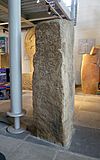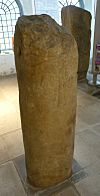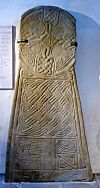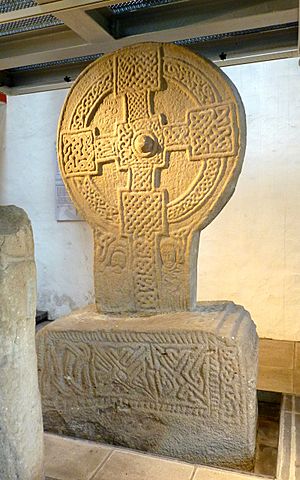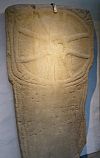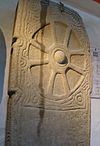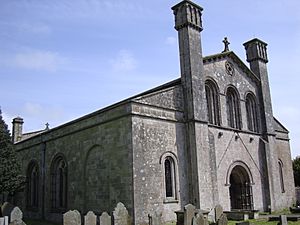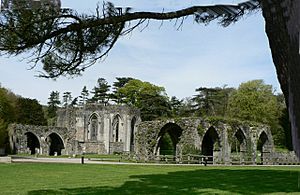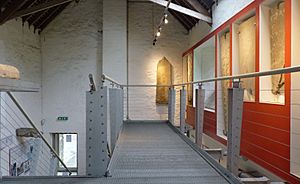Margam Stones Museum facts for kids
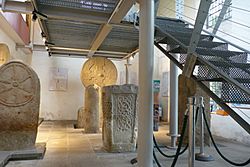 |
|
| Lua error in Module:Location_map at line 420: attempt to index field 'wikibase' (a nil value). | |
| Established | 1892 (1932 in current building) |
|---|---|
| Location | SS80078632, Port Talbot, South Wales, SA13 2TA |
| Type | Museum of early Christian carved stones |
| Nearest car park | On site (free) |
The Margam Stones Museum is a special place in a small Victorian schoolhouse near Port Talbot, South Wales. It holds one of the most important collections of ancient Celtic stone crosses in Britain. These stones were all found near Margam and were gathered mostly in the 1800s. They show us what Welsh Christian culture was like between the 500s and 1500s.
One of the most famous stones is the amazing Cross of Conbelin. It was made around 1000 AD. This huge stone cross has cool Celtic patterns, pictures of people and animals (like a hunting scene!), and messages that tell us who made it. The museum has 17 early Christian stones and 11 other memorials from later times. Cadw, the Welsh agency for historic sites, runs the museum. It's also very close to the old Margam Abbey Church and its ruins.
Contents
Visiting the Museum
The museum is easy to find! Its postcode is SA13 2TA. You can get there from the M4 motorway, just north of Junction 38. It's about 4 miles (6.4 km) south-east of Port Talbot. There's a free car park for visitors to the Abbey, the Museum, and the Abbots Kitchen Restaurant.
History of the Margam Stones
Margam Abbey was a monastery built by Cistercian monks in 1147. Part of it, the nave, is still used today as Margam Parish Church. When monasteries were closed down in 1536, the Mansel family bought the Abbey and built a large house on its land. Later, in 1786, the Talbot family took over the estate.
In the 1800s, the Talbot family started collecting different stone crosses and standing stones from the area. They first put them in their mansion's gardens. In 1892, Emily Talbot gave these important stones to the nation. They were then looked after by the Commissioner of Public Works. In 1932, the stones were moved to their current home, an old church schoolhouse near Margam Abbey Church. More stones from the Abbey and nearby areas were added to the collection. Today, Cadw takes care of them.
What Kinds of Stones Are There?
The museum has about 30 ancient carved stones. Seventeen of these are from before the Normans arrived in Britain (before 1066 AD). You can see these on the ground floor. The other stones are memorials from Margam Abbey, mostly tomb slabs. These are in the upper gallery.
The pre-Norman stones are very special. They are considered one of the most important collections of early Christian carvings and writings in Britain. Many of these stones came from Margam and its nearby villages. Some others were found where the Port Talbot steelworks are now, and a few came from the hills and farms further away.
These stones are part of a larger group found across Glamorgan. They can be put into three main groups:
- Latin Inscribed Memorials: These stones are from 450 to 650 AD. They show us that early Welsh Christian culture was developing. The museum has three stone pillars with early writing, including a Welsh family tree. One stone even has writing in both Latin and Ogham (an ancient Irish alphabet).
- Cross Inscribed Slabs: These are from 600 to 900 AD. They are simpler than the later crosses, with basic cross shapes cut into the stone.
- Sculptured Crosses and Cross Slabs: These are from 900 to 1100 AD. They have detailed patterns like woven designs (interlace) and often include Latin inscriptions. These are the most eye-catching stones in the museum and make up most of the pre-Norman collection.
Amazing Early Christian Stones
The Roman Milepost and Cantusus Stone (No. 1)
This stone was first a Roman milepost from 309–313 AD, marking distances for travelers. Later, in the 6th century, it was turned upside down and reused as a memorial for someone named Cantusus. It's a sandstone pillar, about 5 feet (1.52 meters) tall. It was found in 1839 near a Roman Road by Port Talbot.
- What it says: One side has the Roman Emperor Maximinus's name. The other side says, "Here lies Cantusus – his father was Paulinus."
The Pumpeius Stone (No. 2)
This stone is also called the Kenfig Stone. Local stories say it's the tomb of Prince Morgan. It was first written about in 1578. It's a squared pillar of red sandstone, about 4.4 feet (1.35 meters) tall. It has writing in both Latin and Ogham scripts. The Ogham writing looks like notches along the side of the stone.
- When it's from: 6th century.
- What it says: The Latin says "PUMPEIVS CARANTORIVS," meaning "The stone of Pumpeius, son of Carantorius." The Ogham repeats "Pumpeius" and also says "Rolacun son of Illuna," which are Irish names.
- Where it was found: It used to stand by a road in Kenfig, near a ruined church. It was moved to the museum between 1928 and 1945.
The Bodvoc Stone (No. 3)
This stone pillar is also known as 'The Margam Stone'. It came from a nearby mountain, where it was part of a prehistoric burial mound. A copy of the stone stands there now. People first wrote about it in 1578. There was a local legend that anyone who read the inscription would die soon after! It's about 3.3 feet (1.01 meters) high and has four lines of Latin writing and a carved cross.
- When it's from: Late 6th or early 7th century.
- What it says: It translates to: "The Stone of Bodvoc. Here he lies, son of Cattegern, and great-grandson of Eternalis Vedomavus."
- Decoration: There's a small carved Maltese cross on top.
- Where it was found: It originally stood on Margam Mountain. It was moved to the museum before 1945.
Cross-Marked Slabs
These stones are from 600 to 900 AD. They are simpler than the later, more detailed crosses. Several Margam stones have these carved crosses. Only Stone No. 4 fits entirely into this group.
The Pillar of Thomas (No. 4)
This is a tall, round stone pillar. Its top is broken off. It has three simple Latin crosses carved into it and a short inscription. The pillar is about 3.7 feet (1.14 meters) high. It was found "under a hedge" at Cwrt Uchaf Farm in 1857 and then moved to the Margam collection.
- When it's from: 8th to early 9th century.
- What it says: "TO ME," which means "Thomas." It might refer to the apostle or a local person.
- Where it was found: Cwrt Uchaf Farm, Port Talbot (now under the steelworks).
Sculptured Crosses and Slabs
These beautiful stones are from 900 to 1100 AD. They make up most of the early Christian collection at Margam. Many of them come from the Margam area itself.
The Cross of Einion (No. 5)
This is one of the earliest disc-headed crosses in Glamorgan. The cross and its stem have detailed woven patterns. It was first mentioned in 1873. It's about 6.1 feet (1.88 meters) high and made from local sandstone. Part of the circular head was cut back, probably to reuse it as building material.
- When it's from: Late 9th century.
- What it says: "The Cross of Christ +Enniaun For the soul of Guorgorest Had this made."
- Where it was found: Margam. This stone is the earliest proof that a Christian monastery existed here.
The Cross of Conbelin (No. 7)
This is the largest and most decorated of all the Margam Stones. Experts call it "the most impressive" monument of its kind in Wales! It's a huge stone wheel-cross with intricate knot-work and woven patterns. The main part of the cross has carved figures, possibly St John and the virgin Mary. It sits on a massive stone base with geometric patterns and a hunting scene.
- When it's from: Between 950 and 1050 AD.
- Size: The whole monument is about 8.5 feet (2.61 meters) tall.
- What it says:
- "Conbelin erected this cross for the soul of Ric..."
- "+ Sodna made this cross."
- Where it was found: It was first written about in 1690. It was moved several times before coming to the museum in 1932.
The Cross of Ilci (No. 11) and Cross of Ilquici (No. 12)
These are both "Cart-wheel Crosses." They were found together, being used as a footbridge! This caused a lot of wear to their carvings and inscriptions. They were first noted in 1693. They are very similar and made from local sandstone.
- When they're from: Late 10th or 11th century.
- What they might say:
- Ilci: "Ilci made this cross in the name of God most High."
- Ilquici: "The cross of St Peter Ilquici erected this cross..."
- Where they were found: Cwrt Dafydd Farm, south of Margam.
Later Stones and Memorials
In 1147, the Margam monastery was restarted as a Cistercian Abbey. New monks from France and an English lord meant there wasn't much interest in the older monastery or its stones. The early stones are the main proof that the older monastery existed.
The main part of the Cistercian Abbey Church is still standing today and is used as the Parish Church. The rest of the Abbey buildings, including the Chapter House, became part of the estate owned by the Mansel and then Talbot families. Now, they are part of Margam public park.
The Talbot family collected the early Christian Stones. Later, they were all moved into the current museum. This collection includes five grave-slabs and a statue from before the Reformation (when the Church of England separated from the Roman Catholic Church). There are also four memorial slabs from after the Reformation. After Cadw updated the museum in the 1990s, these later stones were placed in the upper gallery. This helps visitors see the difference between the very old Christian stones and the later memorials.
Most of these grave slabs only show initials. However, three of them have names. These include Robert, Abbot of Rievaulx (from 1307), Henry, the 9th Abbot (from the 1300s), and a partial inscription in Welsh for Elizabeth (around 1600).
See also




